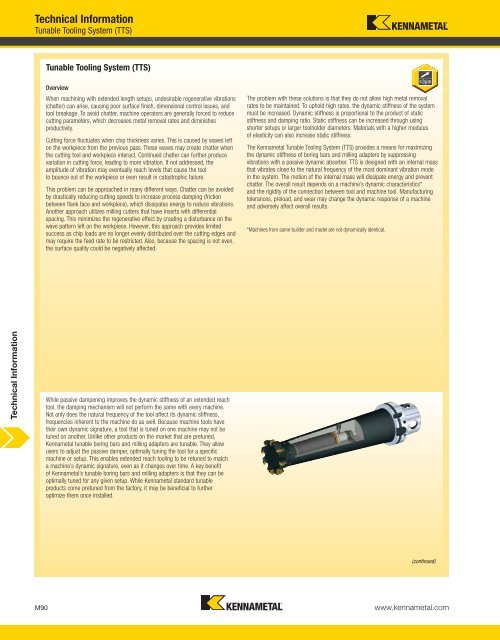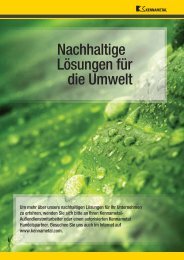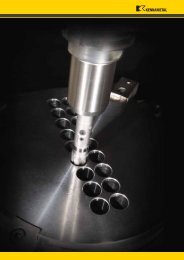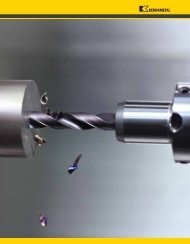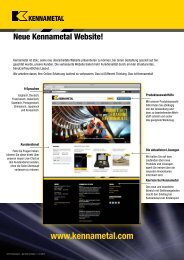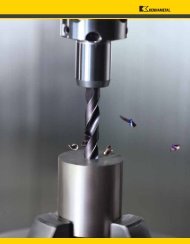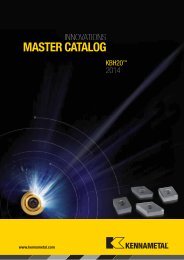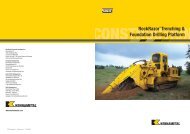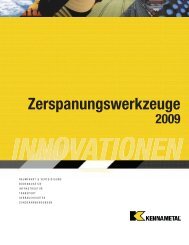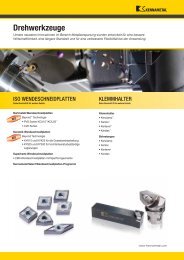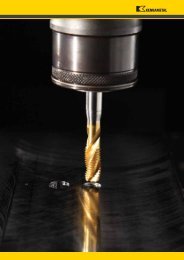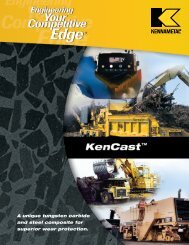You also want an ePaper? Increase the reach of your titles
YUMPU automatically turns print PDFs into web optimized ePapers that Google loves.
<strong>Technical</strong> <strong>Information</strong><br />
<strong>Technical</strong> <strong>Information</strong><br />
Tunable Tooling System (TTS)<br />
Tunable Tooling System (TTS)<br />
Overview<br />
When machining with extended length setups, undesirable regenerative vibrations<br />
(chatter) can arise, causing poor surface finish, dimensional control issues, and<br />
tool breakage. To avoid chatter, machine operators are generally forced to reduce<br />
cutting parameters, which decreases metal removal rates and diminishes<br />
productivity.<br />
Cutting force fluctuates when chip thickness varies. This is caused by waves left<br />
on the workpiece from the previous pass. These waves may create chatter when<br />
the cutting tool and workpiece interact. Continued chatter can further produce<br />
variation in cutting force, leading to more vibration. If not addressed, the<br />
amplitude of vibration may eventually reach levels that cause the tool<br />
to bounce out of the workpiece or even result in catastrophic failure.<br />
This problem can be approached in many different ways. Chatter can be avoided<br />
by drastically reducing cutting speeds to increase process damping (friction<br />
between flank face and workpiece), which dissipates energy to reduce vibrations.<br />
Another approach utilizes milling cutters that have inserts with differential<br />
spacing. This minimizes the regenerative effect by creating a disturbance on the<br />
wave pattern left on the workpiece. However, this approach provides limited<br />
success as chip loads are no longer evenly distributed over the cutting edges and<br />
may require the feed rate to be restricted. Also, because the spacing is not even,<br />
the surface quality could be negatively affected.<br />
While passive dampening improves the dynamic stiffness of an extended reach<br />
tool, the damping mechanism will not perform the same with every machine.<br />
Not only does the natural frequency of the tool affect its dynamic stiffness,<br />
frequencies inherent to the machine do as well. Because machine tools have<br />
their own dynamic signature, a tool that is tuned on one machine may not be<br />
tuned on another. Unlike other products on the market that are pretuned,<br />
Kennametal tunable boring bars and milling adapters are tunable. They allow<br />
users to adjust the passive damper, optimally tuning the tool for a specific<br />
machine or setup. This enables extended reach tooling to be retuned to match<br />
a machine’s dynamic signature, even as it changes over time. A key benefit<br />
of Kennametal’s tunable boring bars and milling adapters is that they can be<br />
optimally tuned for any given setup. While Kennametal standard tunable<br />
products come pretuned from the factory, it may be beneficial to further<br />
optimize them once installed.<br />
The problem with these solutions is that they do not allow high metal removal<br />
rates to be maintained. To uphold high rates, the dynamic stiffness of the system<br />
must be increased. Dynamic stiffness is proportional to the product of static<br />
stiffness and damping ratio. Static stiffness can be increased through using<br />
shorter setups or larger toolholder diameters. Materials with a higher modulus<br />
of elasticity can also increase static stiffness.<br />
The Kennametal Tunable Tooling System (TTS) provides a means for maximizing<br />
the dynamic stiffness of boring bars and milling adapters by suppressing<br />
vibrations with a passive dynamic absorber. TTS is designed with an internal mass<br />
that vibrates close to the natural frequency of the most dominant vibration mode<br />
in the system. The motion of the internal mass will dissipate energy and prevent<br />
chatter. The overall result depends on a machine’s dynamic characteristics*<br />
and the rigidity of the connection between tool and machine tool. Manufacturing<br />
tolerances, preload, and wear may change the dynamic response of a machine<br />
and adversely affect overall results.<br />
*Machines from same builder and model are not dynamically identical.<br />
(continued)<br />
M90 www.kennametal.com


